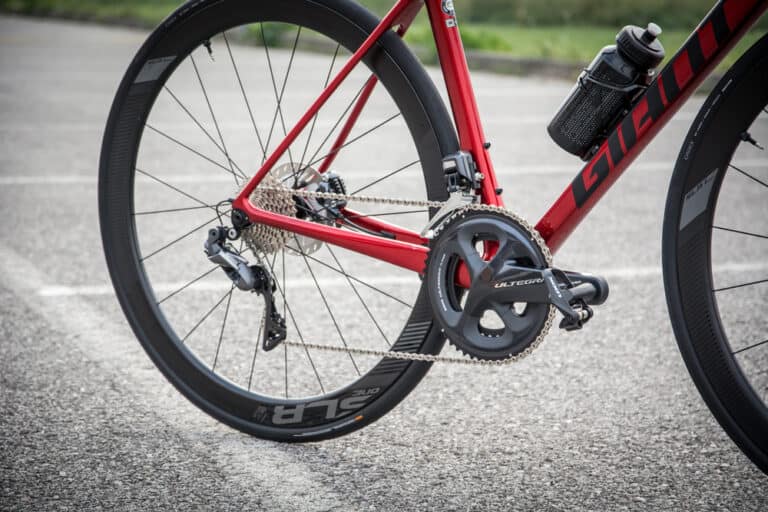Does Road Bike Size Matter?

Editorial credit: ako photography / Shutterstock.com
If you have ever ridden a bike that is way too big or too small for you, you’ll remember how difficult it was to steer and pedal as either you were just able to reach the pedals or your knees were hitting your chin!
Road bike size matters. Being efficient and effective on a bike means that you need to have a frame that is matched your body. If the frame is too big or too small, you won’t be able to deliver the correct power through the crank, and you risk injury, discomfort, and lack of control.
It is vital to understand why it is critical to have the correct road bike size, the processes for measuring and getting properly fitted, and the risks of riding a road bike that is not the right size for you.
Why Do Road Bikes Have Different Frame Sizes?
Buying a road bike starts with the decision to start cycling, but the first major consideration is what size road bike you need. With any bike, there is no ‘one size fits all solution, and this is because everyone’s body dimensions are different.
And here is the evidence that the size of your road bike matters. If it didn’t, there would be just one size frame for everyone! Because people come in every shape and size, road bike frames come in various sizes too!
The frame size will match the rider’s body dimensions, so the larger frames will work for taller and bigger riders, while the medium and smaller frames will be better for shorter riders, ladies, and kids.
The innovation in frame design allows for more ergonomic frames to be produced, and these all assist n creating a more comfortable ride, greater efficiency in energy transfer through the crank, and better control.
Why Getting Fitted With The Right Road Bike Size Matters?
The frame size is the first choice when buying a road bike or any bike. Your bike mechanic or assistant will check your height and recommend a range of matching sizes.
Before pedals or saddle, the frame size is the crucial metric as this will allow you to perform properly on the bike, and the bike techs can then proceed with fitting you.
During a bike fitting, the measurements of your legs and arms and the riding position and if the bike size is wrong, you will never feel comfortable on the bike no matter what you do on the fitting.
Modern fitting uses lasers and precision instruments to measure the length of your whole leg, the size of the lower leg, and your arm’s reach.
They also consider the stroke action and the position of the feet in the cleats (this is why you should have cycling shoes when you get fitted), and ALL of these elements are contingent on having the right road bike size.
Road Bike Frame Size Matters For Power And Efficiency
Road bike cycling is about efficiency and your ability to deliver power through the crank efficiently.
Being energy efficient on a road bike depends on having the correct size, as, without it, you will struggle to improve your times and you will struggle to increase your fitness, all because your road bike size is wrong.
Aside from proper pedaling technique, which is also vital to efficiency, the stroke length combines the frame size and saddle position, allowing your legs to deliver optimum power through the muscles and into the crank.
If the road bike size is incorrect, you will struggle to be efficient, so you will use more energy and become tired faster to cycle a certain distance than you would if you had the right-sized road bike.

Road Bike Size Matters To Prevent Injuries And Discomfort
Aside from poor cycling technique, the biggest cause of discomfort and injury while riding is the improper riding position, and the frame’s size also plays a critical role here.
If your bike size is too small, you will be cramped, and on longer rides, this can result in back and neck pain, leg cramps and joint discomfort, and poor performance due to inefficient mechanics.
Conversely, if your road bike is too big, you will struggle to control your pedaling stroke, steering, and balance, and the same discomfort will apply. On a too-big frame, you will be stretched out, creating back, neck, and shoulder issues and leg and hip problems.
Your other major issue will be the blood and nerve restrictions in the pelvic area. The pudendal nerve runs through the contact point on the saddle, and if your bike size is incorrect, your nether regions are NOT going to be very happy with you at all!
If you had any post-ride romantic ideas setup, well, you can kiss that goodbye as you will be in NO state to participate in anything more than an ice bath and some soft pillows until the numbness and pain dissipate.
So, yes, road bike size matters!
Road Bike Size Matters For Balance And Steering
Finally, we need to consider the effect that the incorrect size road bike will have on your ability to steer and balance on the bike.
With the right size frame, your road bike will be easy to control and steer as well as maintain balance, but if you are too cramped or stretched out, you risk falling or losing control, and on high-speed descents, this could be dangerous, even fatal!
You can oversteer if the bike is too small and understeer if it’s too big, and taking sharp corners without true steering confidence, is brave but foolish and can either lead to a fall or crash.
A road bike that’s too big may be too heavy for you to manage, and one that’s too small could be too light!
Either way, your ability to control, steer and balance on a road bike that is not the correct size will be compromised.
Conclusion
Unlike other aspects of life where size doesn’t matter (so they say), road bike size matters, and if you are going to buy one, take the time and make sure you get the correct size frame for your body type – it will make a world of difference to your enjoyment of the sport!







